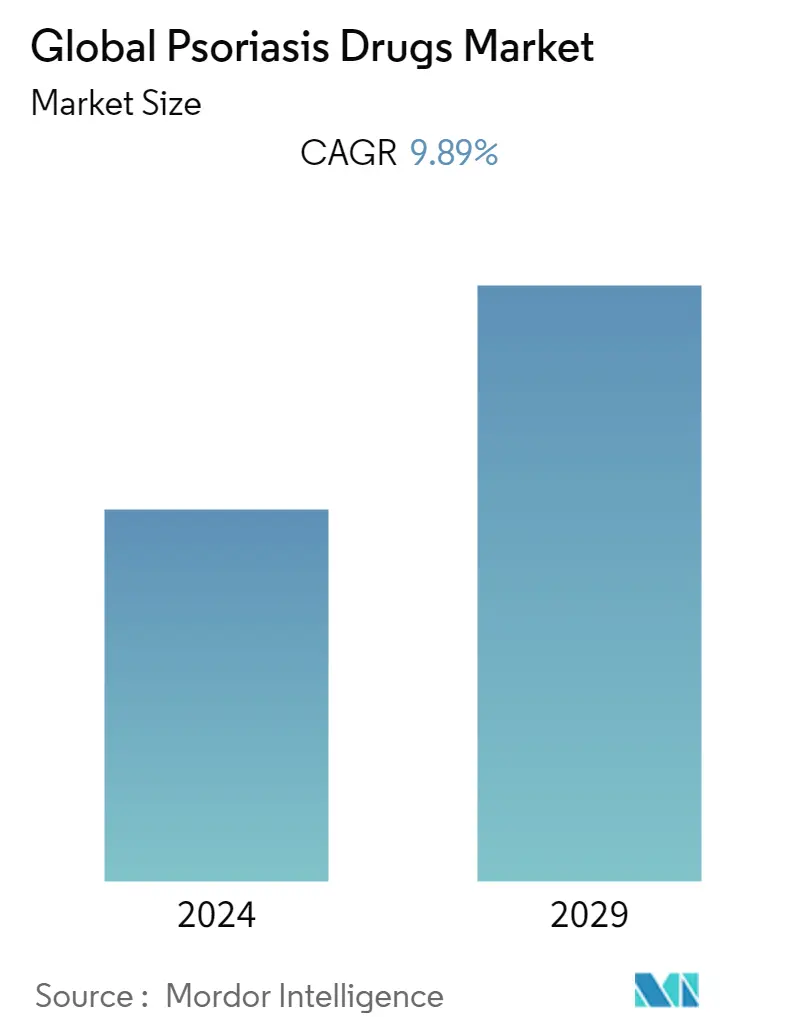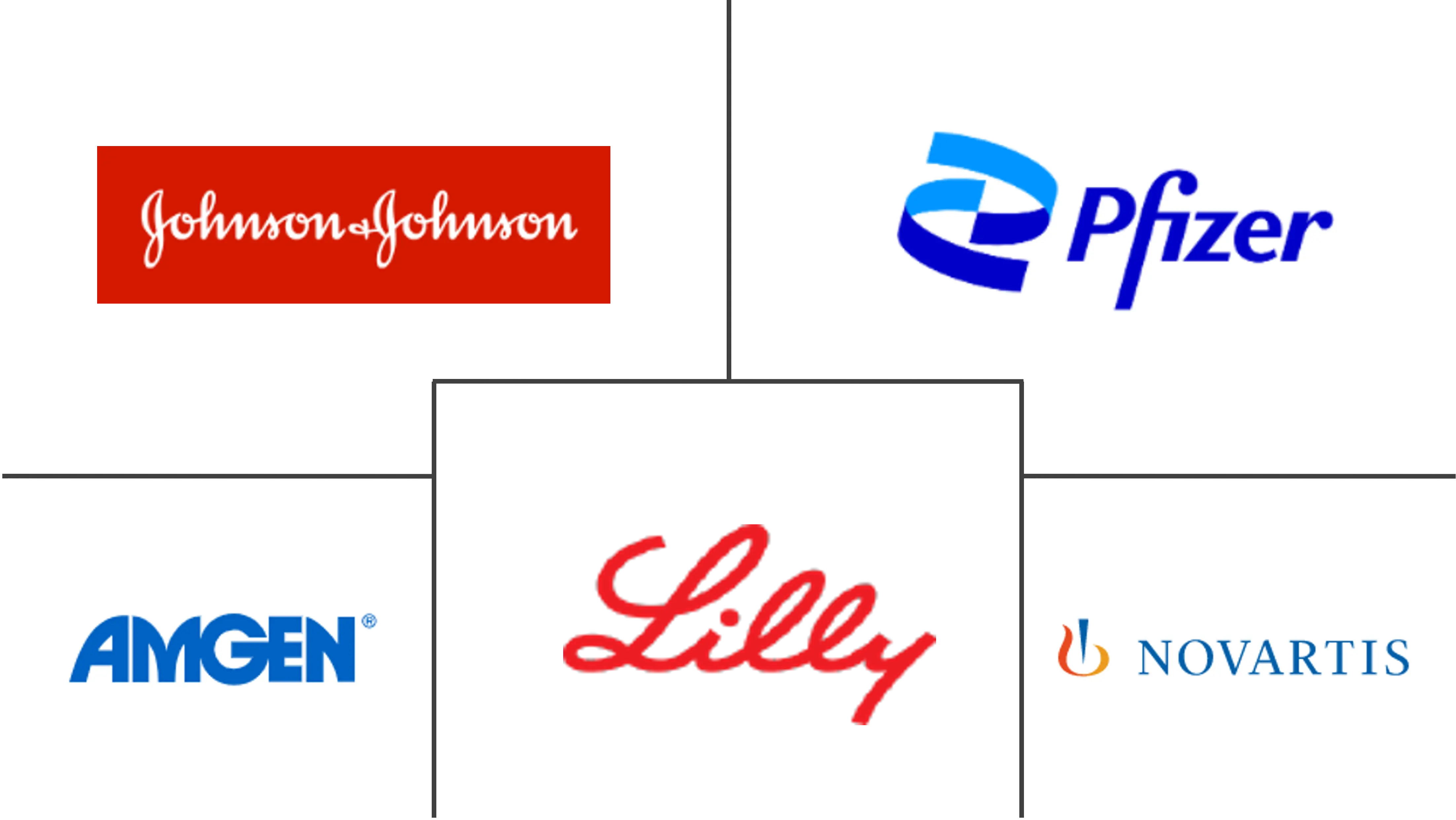Market Size of Global Psoriasis Drugs Industry

| Study Period | 2019 - 2029 |
| Base Year For Estimation | 2023 |
| CAGR | 9.89 % |
| Fastest Growing Market | Asia Pacific |
| Largest Market | North America |
| Market Concentration | Medium |
Major Players
*Disclaimer: Major Players sorted in no particular order |
Psoriasis Drugs Market Analysis
The psoriasis drugs market is expected to register a CAGR of 9.89% during the forecast period, 2022-2027.
The COVID-19 pandemic initially had an adverse impact on the psoriasis market, mainly because of the guidelines published by various regulatory bodies suggesting that patients receiving psoriasis treatment are at more risk of getting infected by COVID-19. In March 2020, the International Psoriasis Council (IPC) recommended physicians to discontinue or postpone the prescription of immunosuppressant medications. However, later in September 2020, researchers from the Perelman School of Medicine at the University of Pennsylvania and 16 other research institutions from the United States and Canada, in collaboration with the National Psoriasis Foundation, created guidelines to care for patients with psoriasis during the coronavirus pandemic. The scientists found no evidence that medical interventions to treat psoriasis and psoriatic arthritis should be interrupted or altered to minimize COVID-19 risks. Such guidelines are expected to augment the market growth pace over the pandemic phase.
An increasing disease burden and demand for psoriasis medicines in emerging economies and the increase in psoriasis research and pipeline drugs are the major factors responsible for the market's growth. Novel drugs with oral administration are opening avenues for needle-averse patients. For instance, in November 2020, Bristol Myers Squibb presented Late-Breaking Phase 2 Data Demonstrating the Safety and Efficacy of Deucravacitinib (BMS-986165) in patients with psoriatic arthritis. It is a driving factor for better uptake among patients averse to injectables.
Also, in December 2021, Amgen received the United States Food and Drug Administration approval for Otezla (apremilast) for treating adult patients with plaque psoriasis. In addition, key players in the market are involved in various business strategies, such as product launches, to expand their product portfolios and gain a competitive edge in the market.
Due to the abovementioned factors, the market is expected to register a high growth rate during the forecast period. However, the adverse side effects of most of the existing medications and the high cost of treatment are expected to hamper the market's growth.
Psoriasis Drugs Industry Segmentation
As per the scope of the report, psoriasis is a genetic condition that may or may not be present at birth but can also be triggered by certain environmental and genetic factors. Factors such as the changing lifestyles of people and their increased inclination toward alcohol consumption and smoking, unhealthy diets, and sedentary living are making people more prone to this condition. The psoriasis drugs market is segmented by type of treatment (biologic drugs, small molecule systemic drugs, and tropical therapies), mechanism of action (TNF alpha inhibitors, PDE4 inhibitors, interleukin inhibitors, and other mechanisms of action), route of administration (oral, parenteral, and topical), and geography (North America, Europe, Asia-Pacific, Middle East and Africa, and South America). The market report also covers the estimated market sizes and trends for 17 countries across major global regions. The report offers the value (USD million) for the above segments.
| By Type of Treatment | |
| Biologic Drugs | |
| Small Molecule Systemic Drugs | |
| Tropical Therapies |
| By Mechanism of Action | |||||||
| |||||||
| |||||||
| |||||||
| Other Mechanisms of Action |
| By Route of Administration | |
| Oral | |
| Parenteral | |
| Topical |
| Geography | ||||||||
| ||||||||
| ||||||||
| ||||||||
| ||||||||
|
Global Psoriasis Drugs Market Size Summary
The psoriasis drugs market is poised for significant growth, driven by an increasing disease burden and the demand for effective treatments, particularly in emerging economies. The market has shown resilience despite initial setbacks due to the COVID-19 pandemic, which prompted regulatory bodies to recommend caution in prescribing immunosuppressant medications. However, subsequent guidelines and research have alleviated these concerns, supporting market expansion. The introduction of novel oral medications has also contributed to market growth, appealing to patients who prefer non-injectable options. Key players in the industry are actively expanding their product portfolios through strategic launches and approvals, further bolstering market dynamics. Despite challenges such as the high cost of treatment and potential side effects, the market is expected to maintain a robust growth trajectory.
North America is anticipated to dominate the psoriasis drugs market, driven by a high prevalence of the condition and a well-established healthcare infrastructure. The region's growth is supported by an increase in disease burden, demand for psoriasis medicines, and a rise in research and pipeline drugs. The United States, in particular, holds a significant market share due to its large patient population and favorable government initiatives. The market's competitive landscape is characterized by the presence of major players who are focusing on expanding their reach in developing regions through strategic alliances and acquisitions. Recent FDA approvals for new treatments, including topical and systemic options, are expected to further accelerate market growth in North America and beyond.
Global Psoriasis Drugs Market Size - Table of Contents
-
1. MARKET DYNAMICS
-
1.1 Market Overview
-
1.2 Market Drivers
-
1.2.1 Increasing Disease Burden and Demand for Psoriasis Medicines in Emerging Economies
-
1.2.2 Increasing Use of Combination Therapies
-
1.2.3 Increase in Psoriasis Research and Pipeline Drugs
-
-
1.3 Market Restraints
-
1.3.1 Adverse Side Effects of Existing Medications
-
1.3.2 High Cost of Psoriasis Treatments
-
1.3.3 Extensive Drug Development and Approval Process
-
-
1.4 Porter's Five Forces Analysis
-
1.4.1 Threat of New Entrants
-
1.4.2 Bargaining Power of Buyers/Consumers
-
1.4.3 Bargaining Power of Suppliers
-
1.4.4 Threat of Substitute Products
-
1.4.5 Intensity of Competitive Rivalry
-
-
-
2. MARKET SEGMENTATION (Market Size by Value - USD million)
-
2.1 By Type of Treatment
-
2.1.1 Biologic Drugs
-
2.1.2 Small Molecule Systemic Drugs
-
2.1.3 Tropical Therapies
-
-
2.2 By Mechanism of Action
-
2.2.1 TNF Alpha Inhibitors
-
2.2.1.1 Etanercept
-
2.2.1.2 Certolizumab Pegol
-
2.2.1.3 Adalimumab
-
2.2.1.4 Infiximab
-
2.2.1.5 Golimumab
-
-
2.2.2 PDE4 Inhibitors
-
2.2.2.1 Apremilast
-
-
2.2.3 Interleukin Inhibitors
-
2.2.3.1 Secukinumab
-
2.2.3.2 Ustekinumab
-
2.2.3.3 Other Interleukin Inhibitors
-
-
2.2.4 Other Mechanisms of Action
-
-
2.3 By Route of Administration
-
2.3.1 Oral
-
2.3.2 Parenteral
-
2.3.3 Topical
-
-
2.4 Geography
-
2.4.1 North America
-
2.4.1.1 United States
-
2.4.1.2 Canada
-
2.4.1.3 Mexico
-
-
2.4.2 Europe
-
2.4.2.1 Germany
-
2.4.2.2 United Kingdom
-
2.4.2.3 France
-
2.4.2.4 Italy
-
2.4.2.5 Spain
-
2.4.2.6 Rest of Europe
-
-
2.4.3 Asia-Pacific
-
2.4.3.1 China
-
2.4.3.2 Japan
-
2.4.3.3 India
-
2.4.3.4 Australia
-
2.4.3.5 South Korea
-
2.4.3.6 Rest of Asia-Pacific
-
-
2.4.4 Middle-East and Africa
-
2.4.4.1 GCC
-
2.4.4.2 South Africa
-
2.4.4.3 Rest of Middle-East and Africa
-
-
2.4.5 South America
-
2.4.5.1 Brazil
-
2.4.5.2 Argentina
-
2.4.5.3 Rest of South America
-
-
-
Global Psoriasis Drugs Market Size FAQs
What is the current Global Psoriasis Drugs Market size?
The Global Psoriasis Drugs Market is projected to register a CAGR of 9.89% during the forecast period (2024-2029)
Who are the key players in Global Psoriasis Drugs Market?
Eli Lilly and Company, Pfizer Inc., Johnson and Johnson (Janssen Global Services, LLC), Novartis AG and Amgen Inc. are the major companies operating in the Global Psoriasis Drugs Market.

